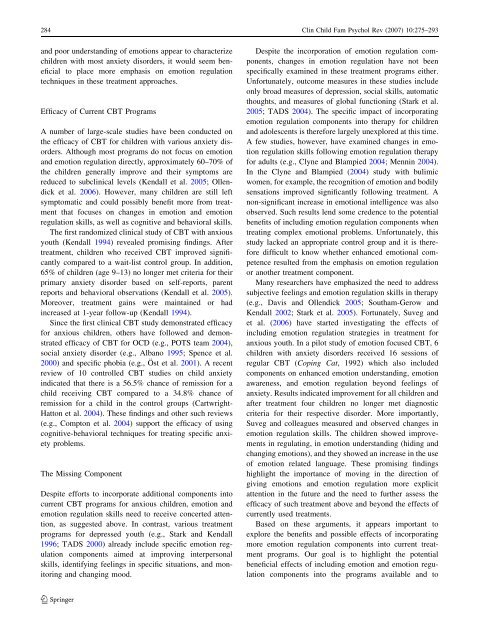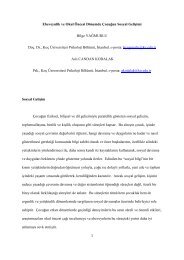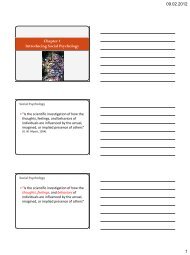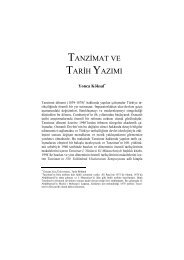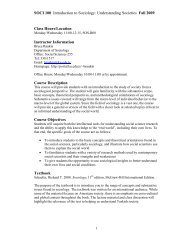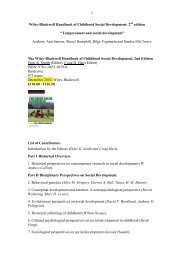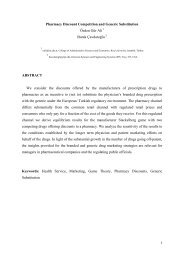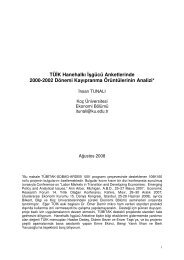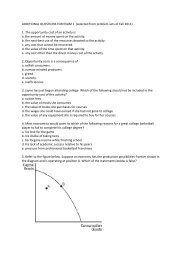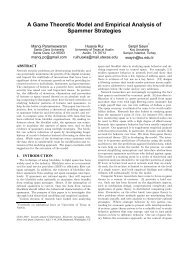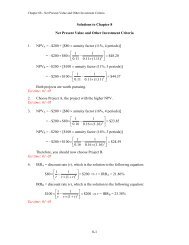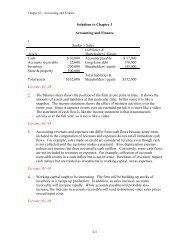The Role of Emotion Regulation in the Treatment of Child Anxiety ...
The Role of Emotion Regulation in the Treatment of Child Anxiety ...
The Role of Emotion Regulation in the Treatment of Child Anxiety ...
You also want an ePaper? Increase the reach of your titles
YUMPU automatically turns print PDFs into web optimized ePapers that Google loves.
284 Cl<strong>in</strong> <strong>Child</strong> Fam Psychol Rev (2007) 10:275–293<br />
and poor understand<strong>in</strong>g <strong>of</strong> emotions appear to characterize<br />
children with most anxiety disorders, it would seem beneficial<br />
to place more emphasis on emotion regulation<br />
techniques <strong>in</strong> <strong>the</strong>se treatment approaches.<br />
Efficacy <strong>of</strong> Current CBT Programs<br />
A number <strong>of</strong> large-scale studies have been conducted on<br />
<strong>the</strong> efficacy <strong>of</strong> CBT for children with various anxiety disorders.<br />
Although most programs do not focus on emotion<br />
and emotion regulation directly, approximately 60–70% <strong>of</strong><br />
<strong>the</strong> children generally improve and <strong>the</strong>ir symptoms are<br />
reduced to subcl<strong>in</strong>ical levels (Kendall et al. 2005; Ollendick<br />
et al. 2006). However, many children are still left<br />
symptomatic and could possibly benefit more from treatment<br />
that focuses on changes <strong>in</strong> emotion and emotion<br />
regulation skills, as well as cognitive and behavioral skills.<br />
<strong>The</strong> first randomized cl<strong>in</strong>ical study <strong>of</strong> CBT with anxious<br />
youth (Kendall 1994) revealed promis<strong>in</strong>g f<strong>in</strong>d<strong>in</strong>gs. After<br />
treatment, children who received CBT improved significantly<br />
compared to a wait-list control group. In addition,<br />
65% <strong>of</strong> children (age 9–13) no longer met criteria for <strong>the</strong>ir<br />
primary anxiety disorder based on self-reports, parent<br />
reports and behavioral observations (Kendall et al. 2005).<br />
Moreover, treatment ga<strong>in</strong>s were ma<strong>in</strong>ta<strong>in</strong>ed or had<br />
<strong>in</strong>creased at 1-year follow-up (Kendall 1994).<br />
S<strong>in</strong>ce <strong>the</strong> first cl<strong>in</strong>ical CBT study demonstrated efficacy<br />
for anxious children, o<strong>the</strong>rs have followed and demonstrated<br />
efficacy <strong>of</strong> CBT for OCD (e.g., POTS team 2004),<br />
social anxiety disorder (e.g., Albano 1995; Spence et al.<br />
2000) and specific phobia (e.g., Öst et al. 2001). A recent<br />
review <strong>of</strong> 10 controlled CBT studies on child anxiety<br />
<strong>in</strong>dicated that <strong>the</strong>re is a 56.5% chance <strong>of</strong> remission for a<br />
child receiv<strong>in</strong>g CBT compared to a 34.8% chance <strong>of</strong><br />
remission for a child <strong>in</strong> <strong>the</strong> control groups (Cartwright-<br />
Hatton et al. 2004). <strong>The</strong>se f<strong>in</strong>d<strong>in</strong>gs and o<strong>the</strong>r such reviews<br />
(e.g., Compton et al. 2004) support <strong>the</strong> efficacy <strong>of</strong> us<strong>in</strong>g<br />
cognitive-behavioral techniques for treat<strong>in</strong>g specific anxiety<br />
problems.<br />
<strong>The</strong> Miss<strong>in</strong>g Component<br />
Despite efforts to <strong>in</strong>corporate additional components <strong>in</strong>to<br />
current CBT programs for anxious children, emotion and<br />
emotion regulation skills need to receive concerted attention,<br />
as suggested above. In contrast, various treatment<br />
programs for depressed youth (e.g., Stark and Kendall<br />
1996; TADS 2000) already <strong>in</strong>clude specific emotion regulation<br />
components aimed at improv<strong>in</strong>g <strong>in</strong>terpersonal<br />
skills, identify<strong>in</strong>g feel<strong>in</strong>gs <strong>in</strong> specific situations, and monitor<strong>in</strong>g<br />
and chang<strong>in</strong>g mood.<br />
Despite <strong>the</strong> <strong>in</strong>corporation <strong>of</strong> emotion regulation components,<br />
changes <strong>in</strong> emotion regulation have not been<br />
specifically exam<strong>in</strong>ed <strong>in</strong> <strong>the</strong>se treatment programs ei<strong>the</strong>r.<br />
Unfortunately, outcome measures <strong>in</strong> <strong>the</strong>se studies <strong>in</strong>clude<br />
only broad measures <strong>of</strong> depression, social skills, automatic<br />
thoughts, and measures <strong>of</strong> global function<strong>in</strong>g (Stark et al.<br />
2005; TADS 2004). <strong>The</strong> specific impact <strong>of</strong> <strong>in</strong>corporat<strong>in</strong>g<br />
emotion regulation components <strong>in</strong>to <strong>the</strong>rapy for children<br />
and adolescents is <strong>the</strong>refore largely unexplored at this time.<br />
A few studies, however, have exam<strong>in</strong>ed changes <strong>in</strong> emotion<br />
regulation skills follow<strong>in</strong>g emotion regulation <strong>the</strong>rapy<br />
for adults (e.g., Clyne and Blampied 2004; Menn<strong>in</strong> 2004).<br />
In <strong>the</strong> Clyne and Blampied (2004) study with bulimic<br />
women, for example, <strong>the</strong> recognition <strong>of</strong> emotion and bodily<br />
sensations improved significantly follow<strong>in</strong>g treatment. A<br />
non-significant <strong>in</strong>crease <strong>in</strong> emotional <strong>in</strong>telligence was also<br />
observed. Such results lend some credence to <strong>the</strong> potential<br />
benefits <strong>of</strong> <strong>in</strong>clud<strong>in</strong>g emotion regulation components when<br />
treat<strong>in</strong>g complex emotional problems. Unfortunately, this<br />
study lacked an appropriate control group and it is <strong>the</strong>refore<br />
difficult to know whe<strong>the</strong>r enhanced emotional competence<br />
resulted from <strong>the</strong> emphasis on emotion regulation<br />
or ano<strong>the</strong>r treatment component.<br />
Many researchers have emphasized <strong>the</strong> need to address<br />
subjective feel<strong>in</strong>gs and emotion regulation skills <strong>in</strong> <strong>the</strong>rapy<br />
(e.g., Davis and Ollendick 2005; Southam-Gerow and<br />
Kendall 2002; Stark et al. 2005). Fortunately, Suveg and<br />
et al. (2006) have started <strong>in</strong>vestigat<strong>in</strong>g <strong>the</strong> effects <strong>of</strong><br />
<strong>in</strong>clud<strong>in</strong>g emotion regulation strategies <strong>in</strong> treatment for<br />
anxious youth. In a pilot study <strong>of</strong> emotion focused CBT, 6<br />
children with anxiety disorders received 16 sessions <strong>of</strong><br />
regular CBT (Cop<strong>in</strong>g Cat, 1992) which also <strong>in</strong>cluded<br />
components on enhanced emotion understand<strong>in</strong>g, emotion<br />
awareness, and emotion regulation beyond feel<strong>in</strong>gs <strong>of</strong><br />
anxiety. Results <strong>in</strong>dicated improvement for all children and<br />
after treatment four children no longer met diagnostic<br />
criteria for <strong>the</strong>ir respective disorder. More importantly,<br />
Suveg and colleagues measured and observed changes <strong>in</strong><br />
emotion regulation skills. <strong>The</strong> children showed improvements<br />
<strong>in</strong> regulat<strong>in</strong>g, <strong>in</strong> emotion understand<strong>in</strong>g (hid<strong>in</strong>g and<br />
chang<strong>in</strong>g emotions), and <strong>the</strong>y showed an <strong>in</strong>crease <strong>in</strong> <strong>the</strong> use<br />
<strong>of</strong> emotion related language. <strong>The</strong>se promis<strong>in</strong>g f<strong>in</strong>d<strong>in</strong>gs<br />
highlight <strong>the</strong> importance <strong>of</strong> mov<strong>in</strong>g <strong>in</strong> <strong>the</strong> direction <strong>of</strong><br />
giv<strong>in</strong>g emotions and emotion regulation more explicit<br />
attention <strong>in</strong> <strong>the</strong> future and <strong>the</strong> need to fur<strong>the</strong>r assess <strong>the</strong><br />
efficacy <strong>of</strong> such treatment above and beyond <strong>the</strong> effects <strong>of</strong><br />
currently used treatments.<br />
Based on <strong>the</strong>se arguments, it appears important to<br />
explore <strong>the</strong> benefits and possible effects <strong>of</strong> <strong>in</strong>corporat<strong>in</strong>g<br />
more emotion regulation components <strong>in</strong>to current treatment<br />
programs. Our goal is to highlight <strong>the</strong> potential<br />
beneficial effects <strong>of</strong> <strong>in</strong>clud<strong>in</strong>g emotion and emotion regulation<br />
components <strong>in</strong>to <strong>the</strong> programs available and to<br />
123


